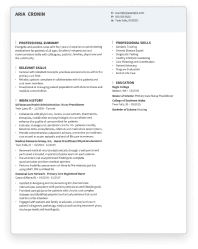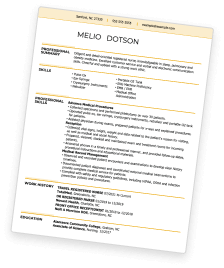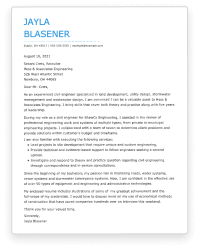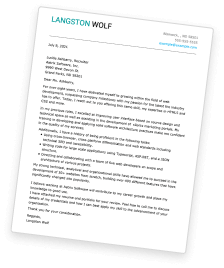Receptionist Resumes: Overview
As a receptionist, you are the heartbeat of any organization. Managing calls, welcoming visitors, and keeping things organized are just some of your essential responsibilities.
Receptionists work in a wide range of organizations, including:
- Corporate Offices
- Medical Clinics
- Hospitality Venues
- Educational Institutions
- Non-Profit Organizations
To succeed as a receptionist, you need exceptional organizational skills, stellar communication, and a friendly demeanor.
Ready to create an impressive resume to elevate your career? Explore our resume examples and downloadable templates for inspiration.
Our examples and guides will help you build a resume that opens doors.
Receptionist Resume: Choose a Format
Writing a winning resume for a receptionist starts with choosing the best template and format to showcase your qualifications. Choose a format that helps you stand out and impress potential employers.
There are three format options for a receptionist resume: chronological, functional or combination. Let’s look at the benefits and drawbacks of each format to help you decide.
Chronological Resumes for Receptionists
A chronological resume is the most traditional format. It provides a detailed work history in chronological order to showcase your work experience and career accomplishments.
Chronological resumes are an excellent choice for an experienced receptionist. They allow you to detail your years of experience, skills, and achievements.
To create a chronological resume, you list your previous jobs, beginning with your most recent position and working backward. Then, in bulleted sentences beneath each job entry, you will describe your most relevant job duties, skills gained and achievements in each role.
Potential employers will be instantly familiar with this resume format, and it is highly compatible with applicant tracking systems (ATS), making it a common choice for a receptionist resume.
However, if you lack relevant experience or have a gap in employment, a chronological resume can draw attention to those details.
Functional Resumes for Receptionists
A functional resume takes a different approach by showcasing your most relevant strengths and transferable skills rather than a timeline of your work experience. This format is particularly beneficial for a receptionist new to the career or with a non-linear career path.
For example, a recent graduate may use a functional resume to emphasize their abilities and knowledge instead of their job history.
However, most employers prefer receiving a detailed work history, and functional resumes are not as ATS-friendly as a chronological format. That doesn’t mean a functional resume can’t work well for you, but it is good to understand its limitations.
Combination Resumes for Receptionists
As the name suggests, a combination resume blends elements of chronological and functional formats. This format places an equal emphasis on your skills and experience.
For example, to create a combination resume, you would place your skills section at the top of your resume, followed by a detailed work history. This makes it a good choice for someone with limited relevant experience who wants to showcase their transferable skills and abilities.
This format lets you spotlight your accomplishments and proficiency in key areas, offering a comprehensive picture of your qualifications. However, this format may result in a longer resume, potentially losing the attention of time-strapped hiring managers.
Choosing a Resume Format
When crafting your receptionist resume, choosing the right format is a critical first step. When in doubt, a chronological format is the most recommended resume format. It is ATS-friendly and easily customizable.
Suppose you are concerned about a lack of experience. In that case, there are ways to tailor a chronological format to emphasize your most relevant skills and abilities, regardless of your previous job titles.
Use the bulleted sentences below each job entry to showcase skills that apply to the receptionist position you are applying to. Read the job description carefully, and think about how your previous jobs required similar skills or abilities.
For example, if you worked in customer service, describe how you greeted customers and helped them find what they were looking for. As a receptionist, you will greet customers or clients and guide them through the office, utilizing the same people skills needed in a customer service position.
How to Write a Receptionist Resume
Once you choose a resume format, you can write your resume content. There are five essential sections to include in a receptionist resume:
- Contact information
- Resume Summary or Objective Statement
- Work HIstory
- Skills
- Education
Each of these sections is vital to making a great first impression and landing a job interview. Let’s explore how to write each section to showcase your best qualities!
Contact Information
First, you will provide your contact information at the top of your resume. Include your full name, city and state, phone number, and professional email address.
You can also include a LinkedIn profile if you like. Just be sure that your profile picture and information are updated and professional in appearance.
Your contact information should be accurate and easy to read. After all, employers can’t schedule an interview if they can’t contact you!
Depending on your resume template, you can format your contact information in various ways. Still, it will look something like this:
Jane Smith
Los Angeles, CA
555-555-5555
jane.smith@fakemail.com
Summary or Objective
Next, you will write a brief introduction to your resume using either a resume summary or an objective statement.
A resume summary briefly overviews your most relevant qualifications and experience level. It is the best choice for an experienced receptionist because it will allow you to highlight your fit for the position.
A resume summary for a receptionist may look like this:
“Efficient and personable receptionist with 5+ years of experience in corporate settings. Proven track record of managing high call volumes and providing exceptional customer service.”
However, an aspiring receptionist without relevant experience should opt for an objective statement to express their enthusiasm for the job and personal qualities that make them a great fit for the role.
For example, an objective statement for a receptionist’s resume might say:
“Energetic and highly organized intern committed to providing exceptional customer service and administrative support. Seeking a receptionist position with a dynamic company to further develop my office administration skills.”
Whether you choose an objective or a summary– tailor this section to each specific position you apply to. Using keywords from the job description can help applicant tracking systems find your resume.
Work History
Next, you will provide a detailed work history. This section is the heart of your resume and provides a comprehensive picture of your experience and achievements.
List your previous jobs in reverse chronological order, starting with your most recent position. Each job entry should include:
- Job title
- Employer name
- Employer’s location (City and State)
- Dates of employment
Then, under each job, write at least three bulleted sentences to describe your responsibilities and accomplishments in each role.
To make this section more compelling to the reader, use strong action verbs like organized, streamlined, coordinated and improved. Action verbs will grab the attention of hiring managers and demonstrate your ability to communicate.
For example, “Organized and stored physical and digital files to improve efficiency throughout the department.”
Also, use numbers and percentages to demonstrate the impact of your previous work. Using data to validate your accomplishments will make a strong impression on hiring managers.
For example, instead of saying, “Scheduled appointments and meetings for the executive team,” you can say, “Scheduled over 20 appointments each week and 24 bi-monthly meetings each year for the executive team.”
Remember to tailor your work history section to demonstrate your fit for the job you are applying to. Focus on experience relevant to the specific job’s requirements to show employers that you have done your research and are genuinely interested in working for them.
For example, if the job posting lists responsibilities like data entry, answering phones and greeting customers, highlight instances where you performed those duties in a previous job.
With all of that under consideration, here’s an example of what the work history section of a receptionist resume may look like:
Front Desk Receptionist
Dynamic Tech Solutions
Austin, TX
June 2020 – Present
- Streamlined the appointment booking process, implementing a new online scheduling system that reduced customer wait times by 30% and increased overall satisfaction ratings.
- Managed over 50 daily incoming calls, efficiently routing them to the appropriate departments, which significantly improved call response time by 20%.
- Developed and maintained a digital filing system for client records, leading to a 25% improvement in retrieval times and contributing to better data management practices.
- Organized and coordinated over 100 business meetings annually, including logistics for video conferencing, which enhanced the executive team’s productivity and collaboration efforts.
- Implemented a customer feedback system that led to a 15% increase in positive feedback on reception services, highlighting an improved visitor experience.
- Assisted with data entry tasks, accurately processing over 200 entries per week, which supported the accounting and HR departments in maintaining up-to-date records.
Skills
Next, you will create a dedicated skills section to show potential employers you are qualified for the job.
As a receptionist, you will need hard skills like data entry and knowledge of standard office equipment.
However, you also need soft skills like collaboration and communication to work well with others.
Although you should tailor the skills section on your receptionist resume, here are the top five hard and soft skills for a receptionist resume to help you get started!
Top 5 Hard Skills for Receptionist Resumes
- Telephone Etiquette: Mastering impeccable telephone etiquette is crucial for a receptionist. Your ability to handle high call volumes with professionalism reflects directly on the organization’s image. Clear communication and courteous interactions over the phone contribute to a positive first impression for clients and visitors.
- Microsoft Office Suite: Proficiency in the Microsoft Office Suite is an essential computer skill for effective document management and correspondence. Receptionists often handle various administrative tasks, including creating and editing documents, managing emails, and organizing schedules. A mastery of these technical tools enhances overall efficiency in daily operations.
- Appointment Scheduling: Receptionists are often responsible for coordinating appointments and managing schedules. A skillful approach to appointment scheduling ensures that the organization operates smoothly, appointments are correctly managed, and clients’ needs are met promptly. It reflects on your organizational abilities and contributes to a streamlined workflow.
- Multitasking: Receptionists navigate diverse tasks simultaneously, making multitasking an essential skill. Juggling phone calls, greeting visitors, and handling administrative duties require the ability to prioritize and manage time effectively. This skill contributes to maintaining order in a fast-paced environment and meeting multiple demands efficiently.
- Customer Service: Exceptional customer service skills are at the core of a receptionist’s role. Engaging with clients and visitors with a friendly and helpful demeanor creates a positive atmosphere. Your ability to provide excellent customer service contributes to client satisfaction, loyalty, and the overall positive reputation of the organization.
Top 5 Soft Skills for Receptionist Resumes
- Communication: Clear and effective communication is fundamental for receptionists. Excellent verbal and written communication ensures smooth interactions with clients, colleagues, and superiors. It fosters a positive workplace atmosphere and enhances the overall professional image of the organization.
- Organization: Receptionists serve as the organizational hub of an office. Strong organizational skills contribute to maintaining a tidy and efficient workspace, managing appointments seamlessly, and ensuring information is readily accessible. This skill is indispensable for creating a well-structured and efficient work environment.
- Adaptability: Receptionists encounter a variety of tasks and situations daily. The ability to adapt to changing priorities, handle unexpected challenges, and thrive in dynamic environments is crucial. Adaptability ensures you can handle diverse responsibilities, contributing to the overall flexibility of the organization.
- Time Management: Efficiently managing time is essential for a receptionist. Prioritizing tasks, meeting deadlines, and coordinating schedules requires effective time management. This skill contributes to the smooth functioning of daily operations, minimizing delays and ensuring that all customers are served promptly.
- Problem Solving: Receptionists often encounter unexpected challenges that require quick thinking and problem-solving abilities. Being adept at finding solutions, resolving issues, and making sound decisions contributes to the organization’s overall effectiveness.
You can format your skill section in various ways; however, it will typically look something like this:
Skills
- Organization and file management
- Multi-line telephone systems
- Microsoft Office Suite and Google Workspace applications
- Verbal and written communication
- Attention to detail
- Customer/client relationship management
Crafting a receptionist resume highlighting your unique skills is the key to success. Once again, you should tailor this section to each job application to emphasize the skills mentioned in the job description.
Education
Next, you will provide your educational background. List your highest level of education, including the degree, name and location of the institution, and your graduation date.
For example, your education section may look like this:
Bachelor of Arts in Business Administration – 05/2016
XYZ University – Burbank, CA
Additional Sections
Once you have completed the five most essential sections of your resume, if space allows, consider including additional sections to enhance your profile.
You can create additional sections to highlight your other unique qualifications such as:
- Certifications
- Languages
- Volunteer Experience
- Professional Associations
For example, including a dedicated section for any professional certifications you have earned can validate your skills and boost your credibility. We have compiled a list of some of the most popular certifications for a receptionist:
Top Certifications for Receptionists
- Certified Administrative Professional (CAP): Demonstrates proficiency in administrative roles.
- Customer Service Certifications: Various online and in-person customer service training programs will certify your commitment to providing exceptional service.
- Microsoft Office Specialist (MOS): Obtaining this certification validates your expertise in office software.
- Professional Receptionist Certification: The National Association of Professional Receptionists offers certifications for receptionists with at least five years of experience as a receptionist, switchboard operator, information clerk, secretary, administrative assistant or greeter.
8 Tips for Writing a Receptionist Resume
Tailor Your Resume: Customize your resume for each job application. Analyze the requirements of the receptionist role you’re applying for, adjusting key details like skills, experiences, and achievements to match the employer’s needs.
Highlight Communication Skills: Elevate your receptionist resume by emphasizing your adept communication skills—detail instances where you effectively communicated with clients, colleagues, and superiors. Illustrate your ability to convey information professionally, fostering positive interactions within the workplace.
Emphasize Organizational Skills: Showcase your organizational prowess by including instances where you successfully managed multiple tasks simultaneously. Provide tangible examples of how you maintained an orderly workspace, coordinated schedules, and ensured seamless operations, underscoring your commitment to organizational excellence.
Quantify Achievements: Make your accomplishments shine by including numbers and percentages. Use numbers to describe experience managing call volumes, coordinating events, or improving efficiency. Numbers provide a clear picture of your impact, validating your capabilities as a highly effective receptionist.
Use Keywords: Make your resume more ATS-friendly by incorporating industry-specific keywords. Tailor your language to align with the job description to help your resume pass through Applicant Tracking Systems (ATS) scans and catch the attention of prospective employers.
Keep It Concise: Capture the attention of potential employers with a concise, one-page resume. Focus on your most relevant experiences and accomplishments. A brief and focused resume helps employers quickly grasp your qualifications, making a lasting impression in a time-efficient manner.
Use Action Verbs: Engage the reader by starting each bullet point with strong action verbs. Action verbs energize your accomplishments and convey confidence.
Proofread Carefully: Thoroughly proofread your resume to eliminate any typos, grammatical errors, or formatting inconsistencies. A flawless document showcases attention to detail and professionalism, ensuring your receptionist resume impresses employers.
Helping Job Seekers Like You


Use Hloom's Resume Builder
Key Takeaways
- Choosing the right format for your experience level is the first step to creating an impressive resume for a receptionist.
- The five essential sections of a resume include contact information, summary or objective, work history, skills, and education.
- Certifications and additional sections can enhance your resume, showcasing your unique qualifications.
- Tailoring your resume to each job application will improve your chances of passing initial scans by applicant tracking systems.
- Use action verbs to engage the reader and convey confidence.
Use Our Cover Letter Builder













